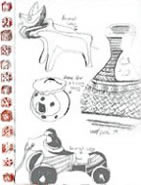
Teach Indus pages produced by History Education Consultancy for educational use only, may not be published elsewhere.
I Home I Young Historian Index I
 2004 Winning Entry - Greasbrough School
2004 Winning Entry - Greasbrough School
A "Big Book" Feedback from the Young Historian Panel:
Three year 6 pupils from this Lancashire School researched their own project. They created a delightful "big book" for display with pockets for antiqued "journals by the first excavators", and a power point show on CD. The book presented these topics; Mohenjo-daro, Leisure Time, Jewellery, Animal bones, Agriculture, Transport, Rulers, Religion, the Decline of the Indus Valley, and the First Excavations.
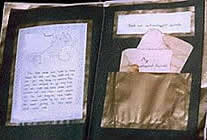
A resource to use interactively!
The children created a great resource for the class, or school to use in future. A project like this could be part of an interactive class museum ! The creators could use post-its to write multiple choice questions with answers underneath. Other children could stick on comments or questions.
Add questions inviting children to build on inferences, and make more general hypotheses or conclusions! Mouseover children's text for feedback and questions arising from their extensive research and thoughtful inferences.
(Refers to QCA scheme of work Key ?'s or similar)
Quotes from the Big Book - Leisure time What can we learn from artefacts?
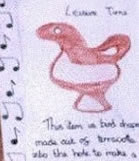 This item is a bird shaped like a bird and is made out of terracotta baked clay. You blow into the hole to make a whistling sound. Children in Indus Valley would probably have used the toy like a whistle or a flute. It was played in religious festivals by the children. Its size is 7.6 cm tall." Think of more uses for a bird whistle!
This item is a bird shaped like a bird and is made out of terracotta baked clay. You blow into the hole to make a whistling sound. Children in Indus Valley would probably have used the toy like a whistle or a flute. It was played in religious festivals by the children. Its size is 7.6 cm tall." Think of more uses for a bird whistle!

How and why can we classify artefacts or interpret them?
These artefacts are dice.They were made of terracotta baked clay and were probably used by children to play with. Children rolled the dice and whoever rolled the highest won. Men may have used them for gambling. Yes, there is more than one way to think about evidence! They are white,  brown and red. They are 3 to 3.8 cm squared.
brown and red. They are 3 to 3.8 cm squared.
This is a baby's rattle. Who might have made this? What else did children have to play with ? It is made from terracotta baked clay with little holes in it. It had small bits of clay inside it to make it rattle. A similar idea is used for modern rattles.
Terracotta artefacts -two moving animals, a home for a living thing, and a vase or pot! What was life like for children in Mohenjo-daro ? What else gives us clues?
Jewellery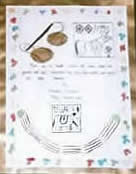
Many people liked to wear jewellery
because it would show that they were quite a wealthy person. Archaeologists think that jewellery was used as gifts to show friendship between different people. Dress to impress!
What jewellery do you think was the most valuable?
Jewellery was also worn by children, because many small bangles were found.
It was made from metal, gemstones and shell.The metal was copper, silver and gold and the gemstones used were carnelian, faience, jasper, onyx, lapis-lazuli, chalcedony and jade. Where did the Harappans get these from? How can we tell these might have been valuable? Ordinary people wore terracotta bangles, because they were not worth a lot. Good point - did ordinary people have other jewellery?
What do photos of artefacts tell us about life in Indus cities?
Agriculture Animal Bones
The Indus Valley, when the waters went away a rich layer of soil was left. Cotton and sesame were planted in Autumn before the floods. In Spring when the water went away wheat and barley were planted. Many animal bones are found in the city of Indus such as Goats, Sheep, Cattle, Rhinoceros, Indian Boar, Buffalo, Elephant, Camel, Tortoise, Deer, Rhino, Dog, Cat and maybe a Donkey. Do you think all these animals were food?
Rulers
Archaeologists havent proved whether the Indus Valley had rulers or not. Some of them believe they did and some believe they didnt. This is probably because there weren't tombs,unlike in Ancient Egypt. Yes! No tombs stuffed with treasure have been found! What if people believed riches couldn't be taken to the next world?

Decline of the Indus Valley How has this been interpreted ?
In the Lower Town of Mohenjo-daro thirty nine skeletons were found in the different streets and houses. Some archaeologists think the Aryans invaded the town and murdered lots of people. So that is why Mohenjo-daro is not lived in any more. Experts ..said the invasion could be true because 23 out of 39 were killed all at once. When did this idea become famous? Which archaeologist said 39 dead bodies were not enough?Some believe that ruling families were fighting each other, and that others were trying to get rid of the rulers. To show disrespect some jealous people smashed and destroyed statues of the rulers. What could have happened to the 39 dead people if her theory is right ?
Some Archaeologists believe that many of the Indus people moved to other areas in an around India. Experts know about this because in places like Pakistan the people speak some words which were believed to come from the Indus Valley.
![]() 2006 Winning Entry - George Hastwell School
2006 Winning Entry - George Hastwell School
The Class Display

Class 3, from this Cumbrian special school for students aged 2 – 19, worked very hard on a project investigating what life was like in the ancient Indus Valley.
The children answered questions by shading in maps and adding details to illustrations. They researched information on the BBC Indus Valley website.

With helpers they created a “big” book, using ‘Inclusive writer’ software with dual symbol and alphabet.
The project included illustration, collage, clay and card modelling, a power point presentation, and a class display of all their work.
They tackled key questions in the QCA scheme of work, plus “why did the Indus Civilisation disappear?”. Their work exemplifies the topic's potential for differentiated learning of the NC History objectives; learners must engage directly with (archaeology) evidence available as there are no narrative sources! Thus they carefully observed photos of artefacts, shown by their drawings and excellent art work, models of animal figurines and pottery, and they interpreted artefacts through these activities.
Interpreting artefacts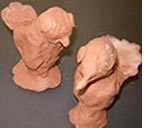
The children decided whether animals portrayed on seals and modelled as clay figurines could have been farm animals, pets or both in a classification activity. They thought birds were both. This is borne out by a terracotta sculpture of bird figurines peeping out of a cage. (See online resources ).
The children modelled wild animals. The concept of wild or hunted (opposite of domesticated) could be added to a classification activity; eg. animals such as rhino, deer, or hare, were depicted on seals and tablets:
Investi gating by modelling !
gating by modelling ! 
The children investigated what pottery was used for. They modelled everyday pots and the characteristic Indus decorated "black on red" pottery.
Classifying evidence
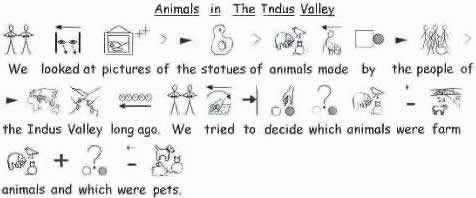
Extract: The category of "wild" or "hunted" could be added
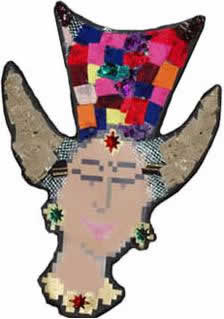 “What did Indus people wear?”
“What did Indus people wear?”
Perhaps the piece de resistance is the childrens interpretations of headdresses. They created their own designs - sparkling collages on card heads.
The children investigated photos of figurines and jewellery, sketching what they thought actual head dresses had looked like. They looked carefully at the elaborate head dresses and jewellery depicted on terracotta figurines, corroborated by jewellery finds of colourful gemstone beads, gold, copper etc.
They concluded that the Indus people dressed in bright colours, as would most archaeologists, though the only surviving evidence of colourfulness is jewellery!
Stimulus activity for "decline" theories, by the class teacher.
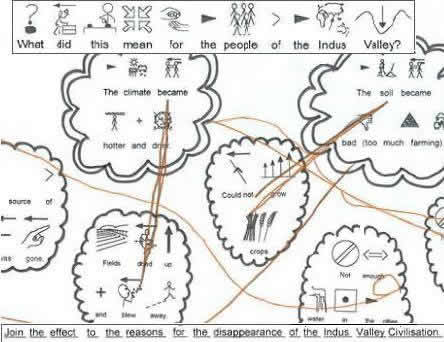
Investigating the Indus Script 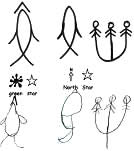
The 'fish' is a frequent sign in the Indus script. The children wrote about or drew Asko Parpola’s theory: he has interpreted 'fish' as a pictorial pun for star = home of God = a God's name, through a root word 'Min' in Dravidian languages which has several meanings - fish/glitter/star.
An activity that could be developed from this work could be a poster, collage (using silver paint!), or animation, to show the visual links between these words.
Inclusive writing and the Indus Script ? 

The Indus script is thought to be logo-syllabic – eg. signs are not pictograms, but have pictorial meanings representing concepts or sounds. Inclusive Writer software uses pictorial symbols for actions or objects. “Stick people” combinations are used for many words. Stick men also feature in the Indus script, so activities picking out these signs, and comparing them are possible. Dr Mahadevan's theory is that they represent different titles of status or office.
![]() The Study School, 2006 Runner Up
The Study School, 2006 Runner Up
Written work by 11 year olds from this Surrey school was a product of group discussion.
Indus Seals
Through close observation of photos, the children noted clues to the way they may have been used, eg. the back perforation allowed a seal to be strung or worn. They had a range of ideas of the purpose of the seal inscripions. They drew excellent inferences and understood there could be several possibilities.
Eg. “the seals were stamps… to be stamped onto items for trade to tell the people on the receiving end how good the items were, the quantity, where they came from and who made or grew the items” and “I think they were used to make an imprint on anything made in the Indus cities”.
One thought the animals on the seals had religious meaning and noticed details which corroborate this theory. “I can see two different types of animals on the seals and under the heads of them (the objects) look like offerings.” (refers to a food or water trough).
Another thought the seal inscriptions represented different cities. This invites further discussion. For example if that were true would we expect animals or the inscriptions on seals found in a particular city to be the same? (No animal motif is exclusive to any site)
Building on this work like this children could devise stylised or abstract versions of their signs, and challenge others to interpret them! This would show ambiguities that occur when humans are devising methods of writing!
"I think they might be for religious ceremonies to burn charcoal or something to make smoke, and then to use the smoke to bless the congregation.
I think this because you could put a strap round the rim " and then they can swing it to bless the congregation. Excellent observation! There were a lot of evidence they were religious so I think it's for religious ceremonies"
"A home air freshener…I thought it was a scented pot… unique shape and height of 30 – 40-cms… so the scent could pass through the holes.
Children’s Theories - the decline of the Indus Civilisation
Evaluating the varied theories about the decline of the Indus Civilisation is a demanding task. They have an interesting history, illustrating changes in archaeology fashion and current controversies. Information about the theories in some commercially produced books for children may omit, or confusingly, present the ideas as fact, not theory.
The children went much further than the KS2 requirement to understand that there are different ways to interpret evidence, and had a stab at evaluating the theories, and developing their own interpretations.
In this case two children only looked at the Mortimer Wheeler (last massacre by alleged invaders) and environmental theories ( floods, earthquakes, rivers drying etc).Their work was a product of thorough discussion. Whilst one concluded Wheeler was correct, they both synthesised the environmental theories, having given examples of the evidence put forward, to explain why attacking invaders were successful in a civilisation possible weakened by other disasters. (Wheeler also hedged his bets this way!) One developed imaginative scenarios by asking what effect the environmental disasters might have on trade and resulting conflict with surrounding tribes.
Shereen Ratnagar's intriguing theory of political crisis with consequences for trade, law and order and civic life, was not used. It is a good one for children to compare with others. They can be asked to construct alternative scenarios around the 38 skeletons of Mohenjo-daro that Wheeler suggested were the remaining evidence of his massacre debunked by the next archaeology generation.
![]() The Study School 2004 Runner-up
The Study School 2004 Runner-up
Feedback from the Young Historian Panel
Individual written work by children, aged 11, comprised this entry. They had discussed photo sources in print and online, and the different theories of archaeologists. Encouraged to speculate and draw conclusions, they successfully grappled with historical thinking. The topics and questions they attempted were; Who Ruled the Indus Civilisation?: Why did the Indus Civilisation Fail?:Seals and Statues, and A Summary of the Indus Civilisation.
Spot QCA KS2 History Learning Objectives!
Children analysed and justified their conclusions from thinking about artefacts and using knowledge from various sources. One cited many (similar) artefacts being found in different settlements as evidence of a powerful trading civilisation. Another considered forensic evidence (partially healing wounds on a skull) to rule out war as a cause of the decline of the civilisation, and had selected and combined information from a range of sources, and in this case, interpretations. She included a range of reasons to explain why she thought that one of a variety of environmental factors was the most likely cause.
Analysing ancient icons - concept of a founding myth!
A third child observed and analysed the sitting position (cross legged, peaceful) of (the Mohenjo-daro) stone statues to suggest the figure might be a representation of a god. He suggested the "Unicorn" on sealsl was a "mythical animal which could have been the "starter" of the civilisation, thus expressing the concept of a founding myth.
